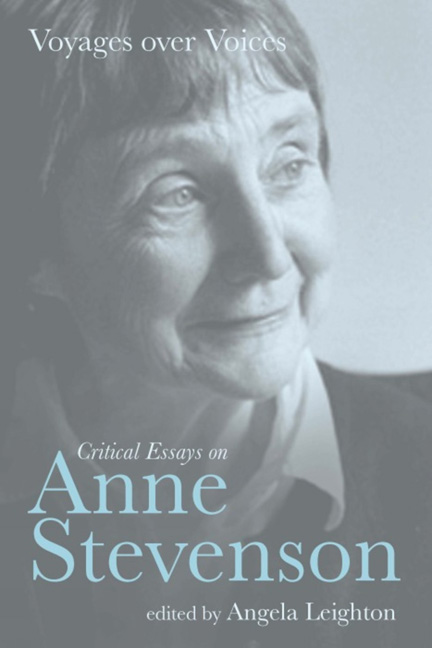Book contents
- Frontmatter
- Contents
- Notes on Contributors
- Acknowledgements
- ‘Making Poetry’
- 1 ‘Voyages over voices’: Introduction
- 2 The Melting Metaphor
- 3 ‘Between us’: Letters and Poems of Stevenson and Bishop
- 4 Mothers, Mirrors, Doubles: Anne Stevenson's Elegies for Sylvia Plath
- 5 Staging Second Thoughts: The Poetry of Anne Stevenson
- 6 ‘Making Poetry’: The Exemplary Anne Stevenson
- 7 ‘A curved adventure’: Romanticism and the Poetry of Anne Stevenson
- 8 The Nature of Anne Stevenson
- 9 Anne Stevenson and the Poetry of Place
- 10 Compacting Time: Anne Stevenson's Poems of Memory
- 11 ‘Not exactly a persona’: Pronouns in Anne Stevenson's Poetry
- 12 ‘To serve a girl on terrible terms’: Anne Stevenson's Writing Selves
- 13 Talking and Singing: Anne Stevenson's Variations on a Rhythmical Theme
- 14 ‘Time will erase’: Anne Stevenson and Elegy
- 15 Observing the Overhearing: The Anne Stevenson Papers in Cambridge University Library
- 16 Bibliography of Anne Stevenson's Published Works
- General Index
- Index of Stevenson's Works
8 - The Nature of Anne Stevenson
- Frontmatter
- Contents
- Notes on Contributors
- Acknowledgements
- ‘Making Poetry’
- 1 ‘Voyages over voices’: Introduction
- 2 The Melting Metaphor
- 3 ‘Between us’: Letters and Poems of Stevenson and Bishop
- 4 Mothers, Mirrors, Doubles: Anne Stevenson's Elegies for Sylvia Plath
- 5 Staging Second Thoughts: The Poetry of Anne Stevenson
- 6 ‘Making Poetry’: The Exemplary Anne Stevenson
- 7 ‘A curved adventure’: Romanticism and the Poetry of Anne Stevenson
- 8 The Nature of Anne Stevenson
- 9 Anne Stevenson and the Poetry of Place
- 10 Compacting Time: Anne Stevenson's Poems of Memory
- 11 ‘Not exactly a persona’: Pronouns in Anne Stevenson's Poetry
- 12 ‘To serve a girl on terrible terms’: Anne Stevenson's Writing Selves
- 13 Talking and Singing: Anne Stevenson's Variations on a Rhythmical Theme
- 14 ‘Time will erase’: Anne Stevenson and Elegy
- 15 Observing the Overhearing: The Anne Stevenson Papers in Cambridge University Library
- 16 Bibliography of Anne Stevenson's Published Works
- General Index
- Index of Stevenson's Works
Summary
If I read a book and it makes my whole body so cold no fire can ever warm me, I know that is poetry. If I feel physically as if the top of my head were taken off, I know that is poetry. These are the only ways I know it. Is there any other way? (Emily Dickinson)
Anne Stevenson, by upbringing if not birth, is an American, although she has spent most of her adult life in Britain, living in a variety of locales in England, Scotland and Wales. Most often she is talked about in terms of contemporary British poets, but I believe this is misguided in some ways. In my view, she might more usefully be considered a poet with strong ties to Emerson, Dickinson, Frost, and the vast traditions of American nature poetry, as one hears the accents of these in much of her work, although the Emersonian note, with its divine afflatus and native optimism, runs against the grain of Stevenson's secular, empiricist streak. (In a letter to me, she once wryly called herself an ‘old-fashioned Darwinian curmudgeon’.)
I have been reading her poems and critical writing with admiration for almost forty years. (We met in Scotland in the early 1970s, when I was a postgraduate student at the University of St Andrews and she had a teaching fellowship at Dundee, and we have remained good friends ever since.) I have always admired her close adherence to the natural world, as well as her intuitive understanding of Emerson's famous notion, so vividly expressed in Nature (1836), that ‘nature is a symbol of spirit’. In this sense, nature in Stevenson seems kinetic, a world of living objects that shift and respond to human needs, physical and shifting, strangely alive. Her landscapes have a kind of listening air, as if expecting to hear something. There is a famous passage in Nature – a passage so well known that it is difficult to read it freshly – where Emerson describes walking across the Boston Common and experiences nature in a way that seems emblematic of all Transcendentalist thinking:
- Type
- Chapter
- Information
- Voyages over VoicesCritical Essays on Anne Stevenson, pp. 116 - 124Publisher: Liverpool University PressPrint publication year: 2010



